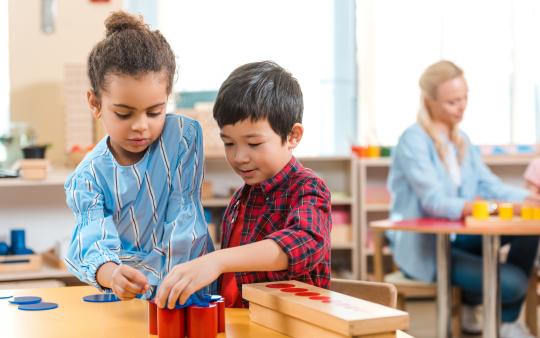The Absorbent Mind: Montessori Education and Early Childhood
© Lightfield Studios/Adobe Stock
The Italian scientist, medical doctor, and educator Maria Montessori (1870-1952) coined the phrase “the absorbent mind” to describe the way in which the brain soaks up everything in its environment during infancy and early childhood. Our current understanding of how the brain develops reinforces the notion emphasized by Dr. Montessori over 100 years ago: that building a strong foundation in early childhood is important for future learning and development. However, this does not imply that children should simply be introduced to more academic content earlier, but rather the implementation of an educational framework that aligns with developmental research would be of great benefit.
What science tells us
Throughout her lifetime, Dr. Montessori developed and refined an educational approach based on scientific observations of human development. Today, researchers have demonstrated that the brain is at its most effortlessly flexible, or absorbent, throughout early childhood. Thanks to technological advances in the field of neuroscience, we can actually see the increase in the number of connections between neurons in the developing brain as a result of interacting with the environment, and we know that significant pruning and refinement of these connections occur in early childhood. This means that connections deemed important and useful are kept, and those that are not are pruned away, allowing the brain to work more efficiently. As Dr. Lise Eliot put it in her book What’s Going on in There? How the Brain and Mind Develop in The First Five Years of Life: "It would be hard to overstate the importance of synaptic refinement to a child's developmental potential...experience - translated into neural activity - decides which connections will be preserved and, consequently, how the brain will be wired for certain ways of thinking, perceiving, and acting" (p. 38).
In her book Montessori: The Science Behind the Genius, Dr. Angeline Stoll Lillard describes the scientific evidence supporting the foundational elements of a Montessori classroom. These include an organized and prepared environment, free choice, intrinsic motivation, concentration, embodied cognition, engagement, interconnection, positive adult-child interactions, and meaningful peer relationships. The following section summarizes how these principles are applied in Montessori classrooms and how they align with developmental and educational research.
Nurturing organized and independent thinking
According to Montessori, “the work of the school is to organize the work of the child…the organizing of the child’s work and offering this work to the child is a very exact work for us…It is the organization of the work which [leads to]…the establishment of mental order” (Montessori 1997, pp. 31–33). Through the preparation of an orderly and predictable learning environment, Montessori teachers are able to provide children with a considerable amount of freedom within the limits and rules of the environment they have prepared.
A prepared environment includes self-correcting and control materials, which allow children to identify and correct their own errors. When errors are constantly corrected by others, and extrinsic rewards are used, self-control is undermined, and children feel that other people are responsible for their outcomes. As Dr. Montessori noted, “All the crosses made by the teacher on the child’s written work only have a lowering effect on [their] energies and interests” (Montessori 1967/1995, p. 245). The freedom and independence that children can achieve within a Montessori environment, with its opportunities for self-correction, foster an intrinsic sense of control, which in turn leads to greater learning and well-being. Engagement in interesting, self-selected activities also fosters the development of fixed attention, deep concentration, and self-regulation.
The importance of movement
Another important component of a Montessori classroom is movement. Through her observations of children, Dr. Montessori noticed that the development of our mind comes about through our movements, indicating that thinking and moving are parts of the same entity. We now know that the brain, including higher-level thinking, or executive functioning, develops in dynamic interplay with the environment. As noted by Dr. Laura Flores Shaw in a recent Huffington Post article, “neuroscience now recognizes that thought is not disembodied, as movement and cognition are closely intertwined.”
There is considerable evidence to support Dr. Montessori's belief that child development is helped by making learning embodied. Tracing letters while making the associated sounds results in better phonetic awareness (the ability to understand the relationship between sounds and letter symbols), and handwriting practice improves the development of literacy. Both of these strategies are used in Montessori classrooms. With this understanding of brain function in mind, Montessori educators create environments where children have constant opportunities for concrete interactions with learning materials. This active engagement promotes cognitive development and allows for the refinement of both gross and fine motor movements. This, in turn leads to the automatization of a large repertoire of movements, freeing up attention for problem-solving, creativity, and comprehension.
Promoting active engagement and collaborative learning
Another way in which Montessori education promotes active engagement is through interconnection. The Montessori curriculum continuously builds on previously mastered concepts and abilities, capitalizing on the notion that learning is more interesting when it is connected to something we already know. Montessori lessons and materials are designed in a logical sequence to provide challenge, but without being so disconnected from previously learned concepts that children feel incapable of success.
Encouraging mastery in this way builds competence and confidence in a child’s capacity for further learning and development. The cognitive neuroscientist Dr. Stanislas Dehaene noted in his book How We Learn "most schools inspired by Montessori today...propose a whole series of rational and hierarchical activities, whose purpose is first carefully demonstrated by teachers before being carried out independently by children. Active engagement, pleasure, and autonomy, under the guidance of an explicit teaching method and with stimulating pedagogical materials: these are the ingredients for a winning recipe whose effectiveness has been repeatedly demonstrated." (pp. 184-185).
In Montessori classrooms, teachers are also trained to provide warm and supportive guidance in ways that are consistent with secure-attachment parenting. Furthermore, autonomy is provided within clear and firm boundaries consistent with authoritative parenting. Current research in developmental psychology has demonstrated that better behavioural and academic outcomes are achieved when quality adult-child relationships are established in early childhood environments.
Montessori environments also foster the ability to relate with peers in a meaningful way while developing close relationships. One way this occurs is through mixed-age classrooms where there is freedom to choose social arrangements based on individual interests and developmental capabilities, leading to collaborative learning. Furthermore, relationships in which older children help younger children are nurtured, and younger children are motivated to work towards higher achievement levels observed in older children.
Fostering self-determination
When the foundational principles discussed above are effectively implemented, Montessori education aligns with self-determination theory, meaning that the following basic human psychological needs are met:
- Autonomy: the sense of control over one’s life
- Competence: the ability to effectively deal with one’s environment
- Relatedness: the ability to establish close relationships with others
Research in the field of psychology has repeatedly demonstrated the benefits of self-determination to overall well-being and life satisfaction. In other words, through fostering self-determination, Montessori education supports the child's development not only for academic purposes but for the entirety of their mature life.
Support for Montessori education also comes from educational research demonstrating that children chosen through a lottery system to attend high-fidelity Montessori schools performed significantly better on objective measures of academic achievement and social cognition, as well as subjective measures of learning enjoyment and engagement. Furthermore, a recent longitudinal study has shown improved performance on a variety of cognitive and socio-emotional measures overtime and a closure in the achievement gap between lower- and higher-income children for those selected to attend public Montessori preschools through randomised lottery. Given that Montessori education correlates with positive developmental, social-emotional, and academic outcomes, it begs the question: why aren’t we implementing Montessori principles throughout our evidence-based public education system?
The future of Montessori education
While Dr. Montessori’s name is most often associated with private schools or alternative education, this is not necessarily what Dr. Montessori had in mind when she was working to develop an education system for all children, and which would lead to the betterment of humanity.
There are clear social and economic benefits to quality public education, including affordability, availability, diversity, equal opportunity, community services, teacher qualifications, and accountability. While there are examples of successfully implemented public Montessori in the United States (including the transition of traditional schools into Montessori schools), Canada, and Europe, for the most part, Montessori education exists on the fringes and is not well regulated. Since the Montessori name is not trademarked and as such can be used by anyone, there are many examples of poorly or even contradictory implementation of Montessori education, stressing the need for regulation and accountability.
Dr. Montessori was a scientist who would not have expected her educational method to remain unchanged, but rather would have strived for continuous evaluation and evidence-based implementation. Current developmental neuroscience suggests that Montessori education provides a learning framework that is based on how the brain actually develops. However, in order to expand upon the growing evidence discussed throughout this article, and to continue to conduct high-quality educational research, implementation of equally-accessible and well-regulated Montessori principles within the public education system is needed. Dr. Montessori believed that “everyone in the world ought to do the things for which [they are] specially adapted. It is the part of wisdom to recognize what each one of us is best fitted for, and it is the part of education to perfect and utilize such predispositions.” In other words, the goal of Montessori education is to build every child’s human potential, and that is something parents everywhere can appreciate and support.
You may also be interested in: How Unschooling Challenges the Traditional School of Thought, Waldorf School and Winter Wonder, and Why School Libraries (Still) Matter.
References
- Eliot, L. (2000). What’s Going on in There? How the Brain and Mind Develop in The First Five Years of Life. Bantam Books: New York, New York.
- Montessori, M. (1997). The California Lectures of Maria Montessori, 1915. Oxford: Clio.
- Montessori, M. (1967/1995). The absorbent mind (C. A. Claremont, Trans.). New York: Henry Holt.
- Dehaene, S. (2020). How We Learn: Why Brains Learn Better Than Any Machine...For Now. Vinking: Penguin Random House LLC.






